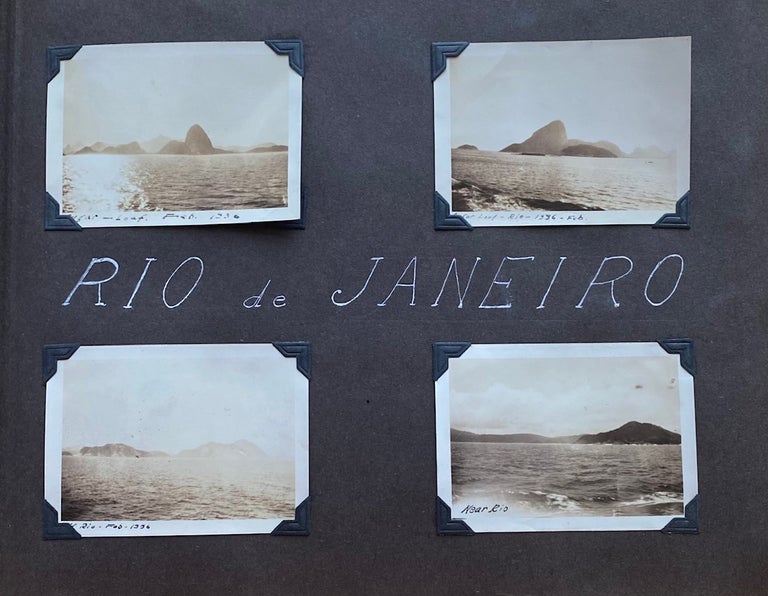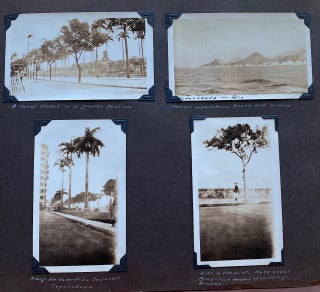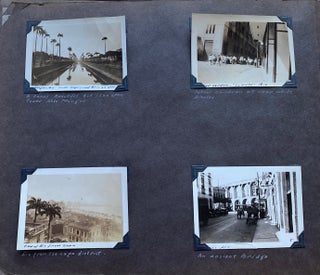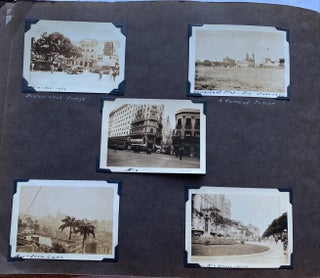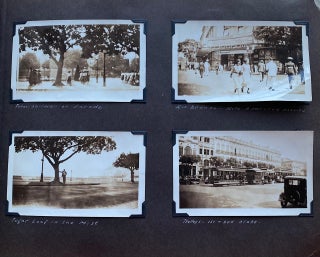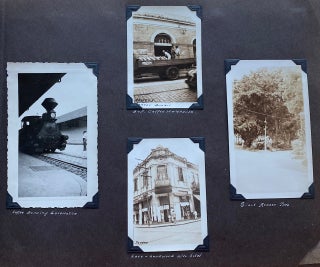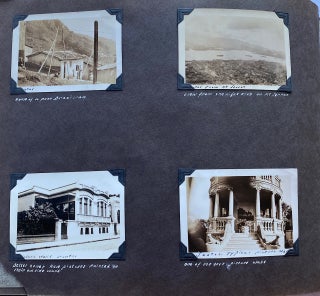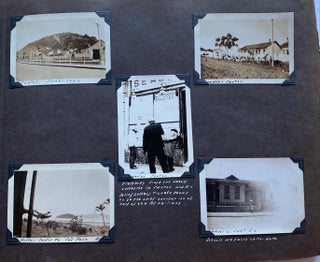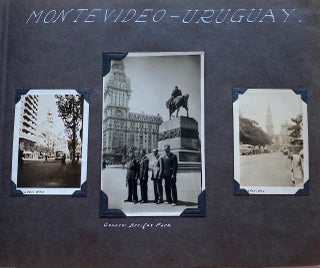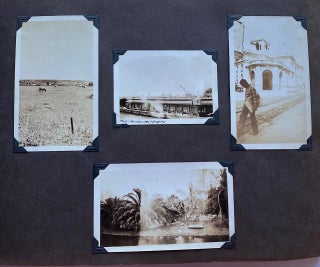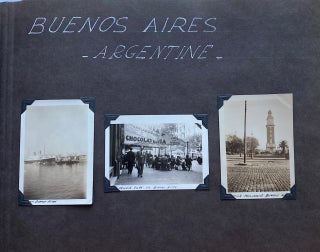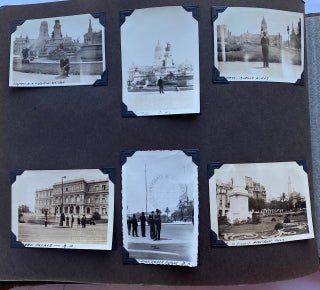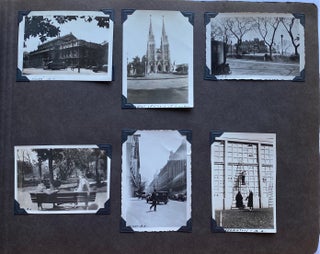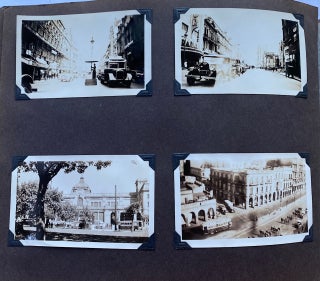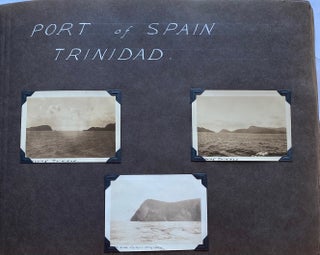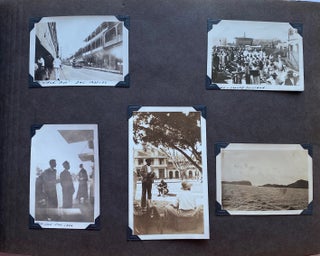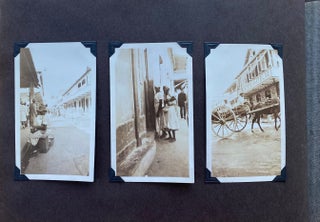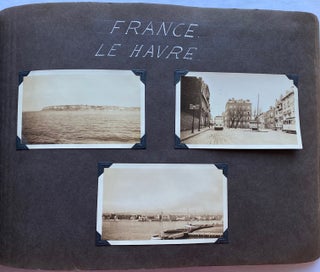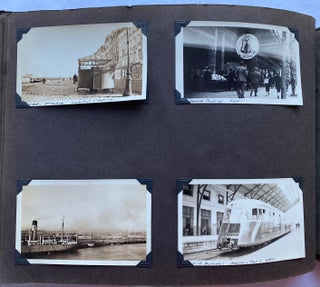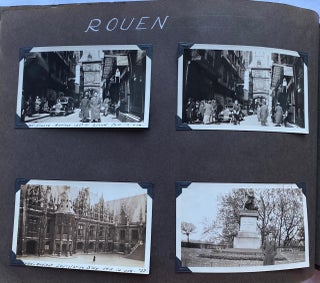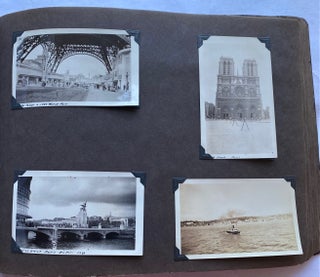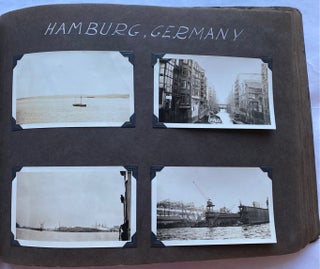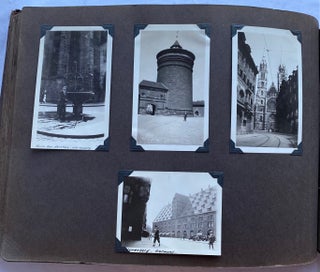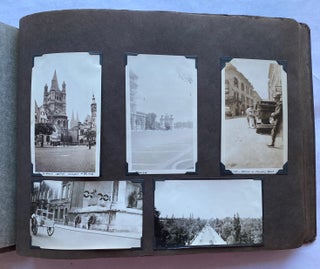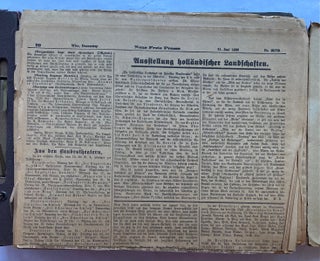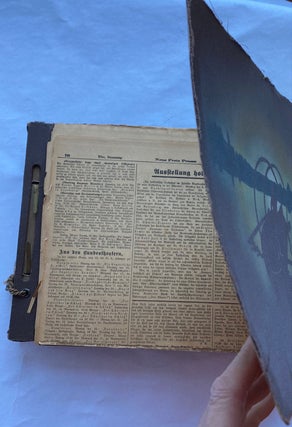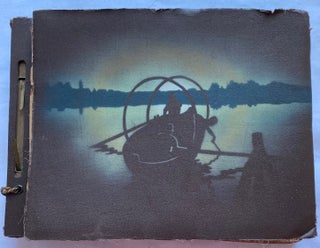SOUTH AMERICA to GERMANY 1930s PHOTO ALBUM
Item #661
Within the context of its fairly conventional form, this quite large (13” x 9 ½”) photo album presents a number of delights, and the odd mystery or two. In its 50 pages (the last 11 of which are blank), the album contains 281 photos, give or take, plus one postcard (views of Rio), one panoramic postcard (a view of Berlin), and one negative. Most of the photos, held in place by black corner mounts, fall into one of two sizes: 3 ½” x 2 ½” or 4 ½” x 2 ¾”, mounted in either landscape or portrait format.. A handful of photos are missing, and a few photos are loose on the page, with no obvious mounting spot. One of the great mysteries of the album is the degree of calculation that has gone into its compilation. The answer is, I think, “a great deal.”
The covers of the album, especially the front cover, are in rough condition. The top layer of the front cover has come loose from its backing board, and one sees inside this opening, or pocket, several folded pages of a newspaper (pages from Neue Freie Presse, a leading Viennese paper), apparently used as filler to give the album cover a padded, spongy feel. The newspaper pages date from 1936, and the album itself was manufactured in Czechoslovakia, so the fact that Neue Freie Presse was a liberal publication, whose correspondents at one time or another included Max Nordau and Theodor Herzl, the co-founders of the Zionist Organization, is probably coincidental. Nevertheless, it is ironic that, in 1938, after the Anschluss, Neue Freie Presse was Aryanized, and then in 1939 was closed down by the Nazis.
The album begins in Rio de Janeiro, and continues with sections devoted to Santos, Brazil, Montevideo, Uruguay and Buenos Aires, Argentina. It then goes on to Trinidad, before heading across the Atlantic for a brief stop in Southampton. Le Harve, Rouen, Paris, Hamburg, Nurenberg [sic], Munich, and Cologne follow, and the album ends in Berlin. However, the organization of the album is not strictly chronological. Photos from Trinidad date from 1935, but by the time we get to Berlin, it is 1937, and the photos from Rio date to February, 1936. So geography, rather than chronology, seems to dictate the progression. If the beginning in Rio is purposeful, one wonders, is the ending in Nazi Berlin also purposeful? This is just one of the album’s mysteries, probably not to be answered satisfactorily.
Oftentimes, a new section in a new city will begin with what might be called an establishing shot: a view of the city as the ship arrives in the harbor, or the view looking out over the city from a high vantage point. In each location, we get fairly standard photos of the usual tourist sites, but also, something more. The compiler, who has at least one traveling companion, perhaps two, has a particular fascination with street-scapes. Sometimes these photos seem relatively straightforward: the citizens of a place going about their business. But as one looks closer, these street-scapes begin to look odd. Oftentimes, there are few people in the street. Sometimes the streets are empty. And in many of the streetscape photos, there is a character I call The Solitary Man. This character is not always the same person. Occasionally, The Solitary Man is rather A Solitary Woman. Occasionally, there are two Solitary Men. Sometimes The Solitary Man is some random person seen on the street, but always placed in isolation in some way. Often, but not always, The Solitary Man is the traveling companion of the photographer, depicted looking at the camera, but often posed in the distance (sometimes the far distance), as though he were hiding in plain sight. In some photos, The Solitary Man figure will be walking one way while the rest of the crowd is going in the opposite direction, and the photographer will frame the photo in such a way that The Solitary Man stands out. Almost every page has at least one example of The Solitary Man, but sometimes, on a page with five or six photos, a candidate for the title will appear in two or three separate photos..
In one photo, we look down a long city street. The camera seems to find nothing of interest. And then, with the aid of a magnifying glass, we find him—The Solitary Man, far in the distance, striding towards the camera, staring at the photographer. Sometimes in a photo there will be multiple candidates competing for the title of The Solitary Man: four men waiting for a bus, or a trolley, perhaps. What links these men is their isolation from each other.
One finds The Solitary Man often enough that one begins to look for him, and feel a certain disappointment when no suitable candidate is apparent. Sometimes the first candidate one seizes on in a photo is indeed not The Solitary Man. One takes a closer look.There he is, further back, posing on the sidewalk and looking at the camera: The Solitary Man.
While the composition of individual photos is excellent, the focus sharp in most cases, contrasts often striking, sometimes the juxtaposition of two or three photos is what makes a page soar. The most notable example is a page where three portrait-oriented photos appear at the top of the page. In the photo on the left, a woman fills up the lower left quadrant of the image, walking towards the photographer but seemingly oblivious to the fact she is being photographed. In the middle photo, a man strides away from the camera. The man is positioned in the lower right quadrant of his photo, but he is further from the camera, and his head is near the center of the photo. In the third photo, on the right, two silhouetted figures in the middle distance mimic the placement of the figures in the other photos. Coincidence? The subtle composition of the page is striking, and feels deliberate, not the result of happenstance.
When the album gets to Germany, one begins to ponder the choice of subject matter from another angle. Why is there a photograph of the Feldherrnhalle, a monument in Munich erected by King Leopold I commemorating the Bavarian army, but repurposed by the Nazis because it was the place where the Beer Hall Putsch ended (and was the destination of the participants). 16 Nazis died there, and the Nazis remade the memorial as a tribute to their fallen comrades. Yet the photograph is taken from the side of the monument, and focuses on two soldiers, standing at attention, guarding the memorial, rather than the monument itself. And then there is the photo of the office of the Fränkischer Kurier, a newspaper in Nuremberg which had become an outlet for Nazi propaganda (though the rabidly anti-Semitic Der Stürmer overtook the Fränkischer Kurier in circulation, and became the unofficial voice of the party, and the government). And then there is the photo of “Adolf Hitler’s office,” Happenstance? A building (and a faceless, bland building it is, Bauhaus-lite) just chanced upon, while walking the streets of Berlin? Or is it a location sought out, photographed as documentation? One wonders.
In no way does this album seem to be sympathetic to the Nazis. It seems rather an amalgamation of the quirkily personal and the subtly political. I think it is a great album, full of unexplained mysteries.
Price: $650.00

